Behind every name, there’s a story. That of Thaddeus takes us from the Biblical Middle East and the deep provinces of Eastern Europe into the wide world of Western civilisation and the heart of modern democracy... Tadeusz has come a long way, from total despair and ‘lost causes’, to advocating freedom for all.
Recognised today as one of the most typical Polish names, Tadeusz wasn’t actually always Polish. Not originally being a Slavic name, it’s popularity in Poland only dates back to the late 18th century and is inextricably linked to characters and historical events lying at the very heart of Poland’s national struggle. But how did Tadeusz travel overseas and become a name of its own in the US?
From Galilee to Lithuania
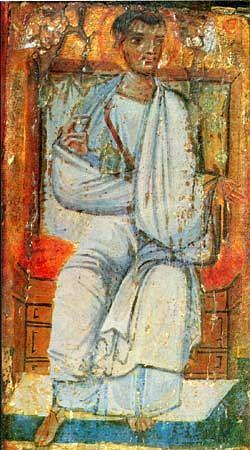 10th-century icon of St. Thaddeus, Saint Catherine's Monastery, Mount Sinai, source: Wikimedia Commons
10th-century icon of St. Thaddeus, Saint Catherine's Monastery, Mount Sinai, source: Wikimedia CommonsUnlike other names traditionally associated with Poland (say, those like Stanisław, Bolesław or Kazimierz, which have also surely gained some worldwide notoriety), Tadeusz is not a name of Slavic origin. The name is actually a Polish version of the Aramaic Thaddai (תדי), which likely derives from the Aramaic word for ‘heart’.
The name Thaddaios (Θαδδαῖος) appears in the New Testament as one of the names of the apostles, Thaddeus-Jude, or simply Jude the Apostle. In the Eastern Christian tradition, the name (Syr. Addai, Rus. Фаддей, Faddei) was preserved in the cult of Thaddeus of Edessa, one of the seventy disciples of Christ and a person often identified with the previously-mentioned Thaddeus-Jude.
But in the Western world, the name with its local versions remained quite rare well into the modern era. Despite notable exceptions such as Italian Renaissance painter Taddeo Gaddi (1290-1366), Irish bishop Thaddeus McCarthy (1455-1492) and Czech astronomer Thaddaeus Hagecius (1525-1600), the name was used rather sporadically. This may partially be explained by the original confusion over the characters of Jude Thaddeus and Judas Iscariot, which people would want to avoid when naming their child.
Meanwhile in Poland
Throughout all this time, the name wasn’t particularly popular in Poland either. In fact, it was seldom used until the 18th century when the name started to spread across the north-eastern parts of the Polish-Lithuanian Commonwealth, which are traditionally referred as Litwa in Polish history and encompass the area of today’s Lithuania and Belarus.
As Polish ethnographer Tadeusz Bystroń argues, the growing popularity of the name very likely resulted from the prominent local cult of Saint Thaddeus. Venerated as the patron saint of lost causes, Saint Thaddeus was often seen as a last resort, the ultimate lifesaver to whom people could offer their prayers. It was during this time, as Bystroń notes, that Polish developed the proverbial saying ‘śpiewać Tadeusza’ (‘to sing Thaddeus’), which essentially meant ‘to be in the utmost misery and bankrupt’.
Kościuszko: the prototypical Tadeusz
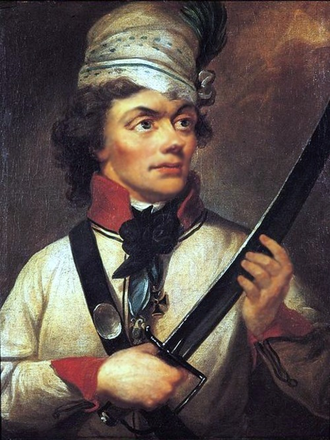 Tadeusz Kościuszko, portrait by Wojniakowski, photo: Wikimedia Commons
Tadeusz Kościuszko, portrait by Wojniakowski, photo: Wikimedia CommonsIt was precisely in this historical area of Litwa that Tadeusz Kościuszko was born in the mid-18th century. A native of Mereczowszczyzna (today: western Belarus), Kościuszko, a young officer in the army of King Stanisław Poniatowski, witnessed the dismantling of the Polish-Lithuanian Commonwealth by partitioning powers. In 1794, he led a failed national insurrection against Russia - the first in a series of national uprisings that would repeatedly shake Polish history across the 19th century.
Wounded in battle and kept as political prisoner by the tsar, Kościuszko became a paragon of virtue for Poles, a figure epitomising the most laudable patriotic sentiments, and a hero of the Polish struggle. Thus, almost inevitably, his first name came to evoke this all too.
Tadeusz becomes a 'Pan'
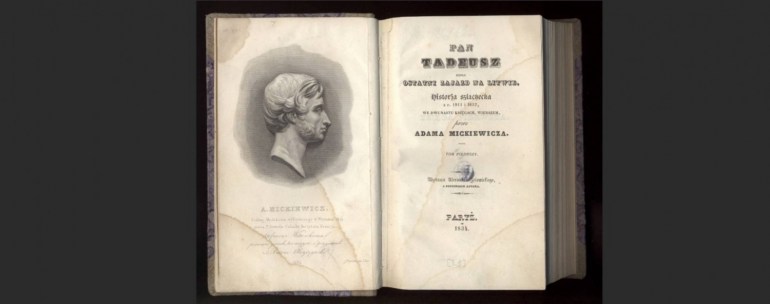 Pan Tadeusz by Adam Mickiewicz was first published in Paris in 1834, source: Polona
Pan Tadeusz by Adam Mickiewicz was first published in Paris in 1834, source: PolonaBut it wasn’t until 1834 and the publication of Adam Mickiewicz’s Romantic epic Pan Tadeusz, that the name gained a wider popularity, and actually started to be recognised as the archetypal Polish first name par excellence.
Mickiewicz wrote his twelve-book poetic magnum opus after the failure of the November Uprising in 1830. Through his text, he returned to the serene days of his childhood back in his native realm, which also happened to be Litwa.
For the creation of what would end up the most famous character in Polish literature, Mickiewicz chose the name Tadeusz for his protagonist. As we learn quite early on in the poem, this boy, full name Tadeusz Soplica, was even born in 1794, namely the same year Kościuszko had led that first insurrection.
The poem also describes how a portrait of Kościuszko adorns the walls of the Soplica family manor. Curiously, it is displayed alongside portraits of two other local heroes of outstanding political merit: Reytan and Korsak. These two statesmen shared not only repute for their support of the Polish national cause (Reytan opposed the partitions and was famously later portrayed by the painter Jan Matejko; Korsak was one of the leaders of the Kościuszko Uprising) but also a first name… that’s right: Tadeusz. Unsurprisingly, they also both harked from that same region of the old Lithuanian Duchy.
Throughout the next century, the name Tadeusz was often given to new-born Polish boys. It was an unmistakeable demonstration of a family’s patriotic feelings and their allegiance to the political tradition of the long-lost Rzeczpospolita.
It became so widespread, it had also come to be perceived as a typical, or even archetypal, Polish name outside of Poland. A possible testimony to tahis are the literary works of Balzac (consider the character of Tadeusz Pac in La Fausse Maîtresse) and Thomas Mann (Tadzio in Death in Venice)
Thaddeus: an American story
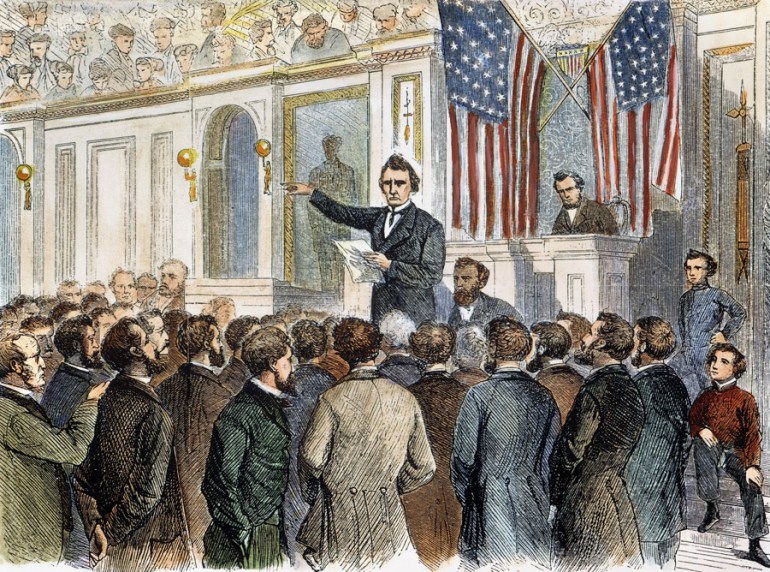 Thaddeus Stevens was named after Kościuszko; coloured wood engraving from a contemporary American newspaper, dated 2nd March 1868, photo: The Granger Collection, New / Forum
Thaddeus Stevens was named after Kościuszko; coloured wood engraving from a contemporary American newspaper, dated 2nd March 1868, photo: The Granger Collection, New / ForumBut how did the name Tadeusz travel overseas and gain popularity as Thaddeus in America? Here, once again, the impact of Tadeusz Kościuszko’s persona was crucial, and once again it was a book, this time quite a different one, which contributed to the American fame of the name.
Kościuszko had actually become a hero in America before he became a hero in Poland. In 1776, almost two decades before the insurrection that made him famous in his homeland, Kościuszko travelled to North America where he spent the next 8 years fighting in the American Revolutionary War, specifically as an officer in the Continental Army. He made his name as a brilliant engineer and fortification builder, among them those at West Point. His strategic talents came to a head at the Battle of Saratoga.
Long after his return to Europe (and role in the Polish insurrection), Kościuszko was cherished as an American national hero. His long-time pen friendship with Thomas Jefferson, one of the authors of the Declaration of Independence, and the subsequent story of Kościuszko’s last will and testament was seen by historians as a potential alternate path for the abolishment of slavery in America.
Among the earliest famous Americans to bear his name were the Republican politician Thaddeus Stevens (born 1792) and inventor Thaddeus Fairbanks (born 1796). The political activity of the former, a voted abolitionist and the fighter for the rights of slaves, can be seen as a virtual continuation of Kościuszko’s political legacy and a fascinating case of what seems like metaphysical affinity.
But while Kościuszko’s feats in the American Revolutionary War and moral goals of freedom and equality for all surely helped transport the name across the Atlantic, it was again a book that succeeded in popularising the name on an all-national plane.
Thaddeus of Warsaw
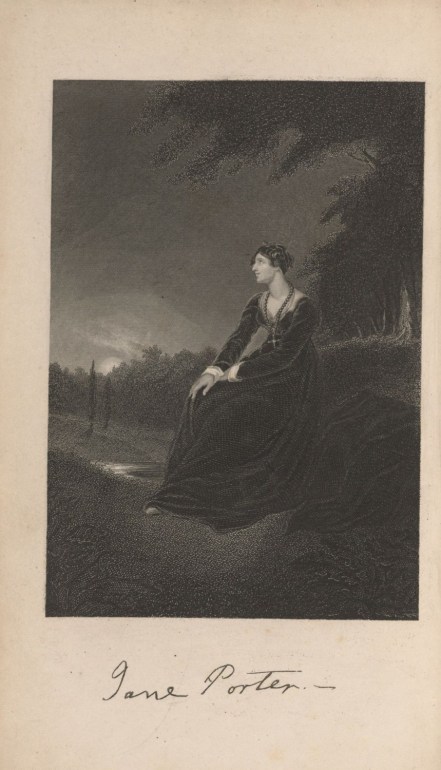 Engraving of the author from an 1846 edition of The Pastor's Fireside, source: public domain
Engraving of the author from an 1846 edition of The Pastor's Fireside, source: public domainThis time it was not a poem but a novel. Written by Scottish author Jane Porter and published in 1803, Thaddeus of Warsaw was inspired by Kościuszko’s story but was not a straightforward rendition of his accomplishments. Despite sharing many traits and biographical facts from Kościuszko’s life, the Thaddeus in Porter’s novel is a quasi-fictional character, a descendant of the Polish royal family of Sobieski (which is also Thaddeus’ last name), and of mixed Polish-British ancestry.
The book was tremendously popular in the early 19th century, becoming a bestseller in America. It’s believed that the book’s popularity contrubuted to many American towns being (re-)named Warsaw.
The fame of Kościuszko and the popularity of Porter’s book is attested in the first names of many important figures from that period in American history. For example, there was Thaddeus Cahill (1827), an inventor credited with inventing the first electro-mechanical musical instrument, and Thaddeus C.S. Lowe (1832), also an inventor and a pioneering aeronaut of the Civil War era. And if you had any doubts, the S. in the latter’s name stands for Sobieski, so the homage to the novel’s character couldn’t be any more direct.
Tadeusz / Thaddeus today
And what about Tadeusz today? Having been popular in Poland for over 150 years, the name’s popularity began to wane in the 1950s. Seventy years later (2015), only 415 Polish babies were named Tadeusz, placing it an number 76 on the list of most popular Polish names (which is actually an increase from 2014, when only 358 babies were given the name).
In the USA, the peak in the name’s popularity came, quite unsurprisingly, in 1918, which is the year Poland regained independence after 123 years of political inexistence. That year Thaddeus placed 303rd (out of a million babies born that year, 313 were named Thaddeus), a fact which can be seen as confirmation of its perceived Polish connection. Last year (2015), the name Thaddeus placed 962nd in popularity, but a year earlier it reached a peak of 666th.
Contemporary famous Americans to bear the name of Kościuszko incluse the 49ers quarterback Thaddeus Lewis, and the NBA basketball player Thaddeus Young.
Readers interested in Polish culture, should familiarise themselves with these outstanding Polish artists who all went by the name Tadeusz:
Author: Mikołaj Glińśki, 27 November 2016; ed. az